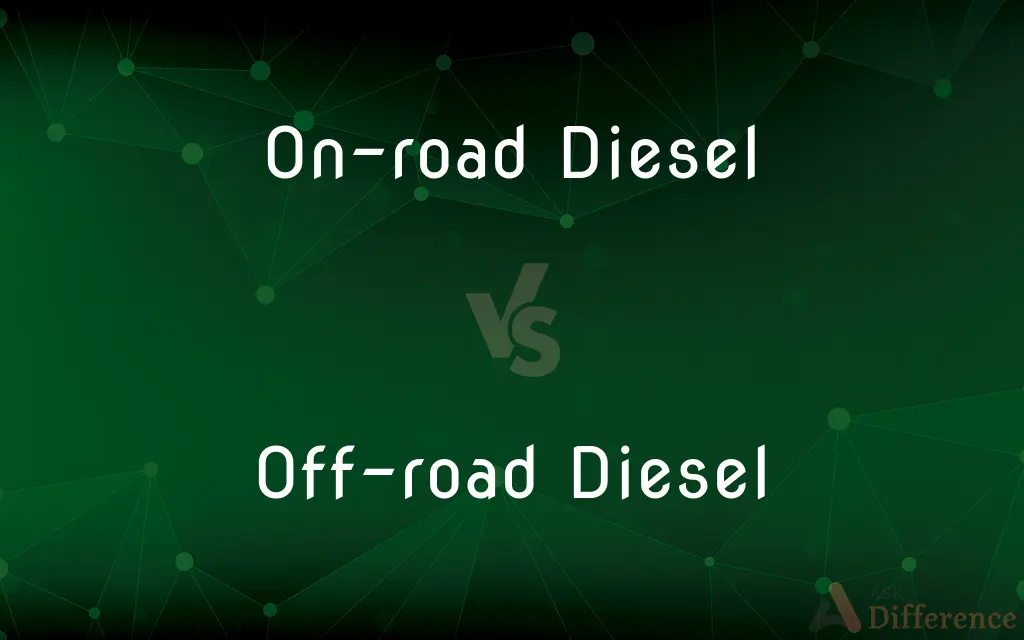On-road Diesel vs. Off-road Diesel — What's the Difference?
By Maham Liaqat & Fiza Rafique — Published on September 25, 2024
On-road diesel is taxed and used for vehicles on public roads, offering clear emissions standards, whereas off-road diesel, dyed red, is tax-exempt for specific non-road uses, such as in agriculture and construction.

Difference Between On-road Diesel and Off-road Diesel
Table of Contents
ADVERTISEMENT
Key Differences
On-road diesel, also known as clear diesel, is formulated for use in vehicles that operate on public roads and highways. It is subject to federal and state taxes and adheres to strict environmental regulations regarding sulfur content to minimize air pollution. On the other hand, off-road diesel is dyed red to indicate its tax-exempt status and is intended for use in vehicles and equipment not used on public roads, such as agricultural tractors, construction machinery, and generators.
While on-road diesel must meet stringent emissions standards set by the Environmental Protection Agency (EPA) to reduce the release of harmful pollutants, off-road diesel, although also regulated, has historically been permitted to have a higher sulfur content. However, regulations have tightened over the years, reducing the sulfur content in off-road diesel to improve air quality and align more closely with on-road diesel standards.
The taxation on on-road diesel is intended to fund highway and infrastructure projects, reflecting its use in vehicles that contribute to road wear and tear. In contrast, off-road diesel benefits from a tax exemption to lower the operational costs in sectors like agriculture and construction, which are essential for the economy but do not directly contribute to road traffic.
One of the most noticeable differences between the two types of diesel is the red dye added to off-road diesel. This dye is used to differentiate it from on-road diesel and to prevent the illegal use of tax-exempt fuel in on-road vehicles. Authorities can easily test for the presence of red dye in the fuel tanks of vehicles suspected of using off-road diesel for on-road purposes, leading to fines and penalties.
Despite the differences in intended use, taxation, and dye coloring, both on-road and off-road diesels are similar in their basic chemical composition and function. They both power diesel engines by igniting fuel through compression, offering energy efficiency and reliability for various applications. The choice between on-road and off-road diesel ultimately depends on the specific requirements and legal uses of the diesel-powered equipment or vehicles.
ADVERTISEMENT
Comparison Chart
Taxation
Subject to federal and state taxes
Tax-exempt for non-road use
Usage
For vehicles on public roads
For agricultural, construction, and other non-road machinery
Sulfur Content
Lower sulfur content to meet EPA standards
Historically higher sulfur, but standards are aligning
Coloring
Clear or slightly yellow
Dyed red to indicate tax-exempt status
Regulatory Standards
Must adhere to strict emissions standards
Subject to regulations, but with some differences in standards
Compare with Definitions
On-road Diesel
Typically clear or slightly yellow.
The fuel dispensed at public gas stations for diesel vehicles is on-road diesel, which is clear.
Off-road Diesel
Reduces operational costs in essential sectors.
Off-road diesel lowers expenses for construction projects by exempting fuel from road taxes.
On-road Diesel
Illegal to use in non-road vehicles to avoid taxation.
Using on-road diesel in farm equipment is legal, but using off-road diesel in on-road vehicles is not.
Off-road Diesel
Adjustments to align with on-road diesel standards.
New off-road diesel formulations have lower sulfur content to meet environmental regulations.
On-road Diesel
Diesel fuel taxed and regulated for use in vehicles on public roads.
The trucking company purchases on-road diesel in bulk to fuel its fleet of delivery trucks.
Off-road Diesel
Tax-exempt diesel fuel for agricultural, construction, and other non-road applications.
The farmer filled his tractor with off-road diesel, taking advantage of the tax exemption.
On-road Diesel
Funds highway and infrastructure projects.
The taxes on on-road diesel help finance road maintenance and construction.
Off-road Diesel
Dyed red to prevent illegal use in on-road vehicles.
The red dye in off-road diesel helps authorities identify misuse in on-road vehicles.
On-road Diesel
Meets strict EPA regulations for air quality.
Modern on-road diesel engines use low-sulfur fuel to comply with environmental standards.
Off-road Diesel
Subject to different standards than on-road diesel.
Off-road diesel regulations accommodate a broader range of sulfur content than on-road standards.
Common Curiosities
Why is off-road diesel dyed red?
To indicate it is tax-exempt and prevent its illegal use in on-road vehicles.
Can I use off-road diesel in my truck?
No, it is illegal to use off-road diesel in vehicles that operate on public roads due to its tax-exempt status.
What happens if I'm caught using off-road diesel in an on-road vehicle?
You could face heavy fines and penalties for tax evasion.
Why does on-road diesel have stricter emissions standards?
To protect air quality and public health by reducing pollutants from vehicles on public roads.
Can on-road diesel be used in farm equipment?
Yes, but it is more cost-effective to use tax-exempt off-road diesel for such purposes.
How do the costs of on-road and off-road diesel compare?
Off-road diesel is generally cheaper for eligible users due to its tax-exempt status.
What is the purpose of the tax on on-road diesel?
To fund highway and infrastructure maintenance and development.
Can the red dye in off-road diesel harm my engine?
No, the dye does not affect the fuel's performance or engine health.
Are there environmental benefits to the regulations on diesel?
Yes, reducing sulfur content in both types of diesel helps lower emissions and improve air quality.
Is there a performance difference between on-road and off-road diesel?
No, the performance is similar, but the main differences are in tax status, dye color, and sulfur content regulations.
How do authorities detect illegal use of off-road diesel?
They can sample the fuel in a vehicle's tank to check for the presence of red dye.
Has the sulfur content in off-road diesel changed over time?
Yes, it has been reduced over the years to meet tighter environmental standards.
How is off-road diesel regulated?
It's regulated by both federal and state laws, focusing on its use, sulfur content, and tax-exempt status.
Is it possible to remove the red dye from off-road diesel?
Technically, it might be possible, but attempting to do so is illegal and not recommended.
What sectors primarily use off-road diesel?
Agriculture, construction, and industries that operate equipment not used on public roads.
Share Your Discovery

Previous Comparison
Exotoxins vs. Endotoxins
Next Comparison
Diabetes Mellitus vs. Diabetes InsipidusAuthor Spotlight
Written by
Maham LiaqatCo-written by
Fiza RafiqueFiza Rafique is a skilled content writer at AskDifference.com, where she meticulously refines and enhances written pieces. Drawing from her vast editorial expertise, Fiza ensures clarity, accuracy, and precision in every article. Passionate about language, she continually seeks to elevate the quality of content for readers worldwide.













































